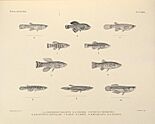Striped nothobranch facts for kids
Quick facts for kids Striped nothobranch |
|
|---|---|
| Conservation status | |
| Scientific classification | |
| Synonyms | |
|
Fundulus taeniopygus (Hilgendorf, 1891) |
The striped nothobranch (Nothobranchius taeniopygus) is a type of freshwater fish found in East Africa. It belongs to a group of fish called Aplocheilidae.
This fish can grow up to about 5.5 centimeters (2.2 inches) long. Male striped nothobranchs are easy to spot because they have special markings. Their scales have bold black edges. Their anal fin (the fin on their belly) and caudal fin (their tail fin) have a black edge with a lighter band just below it. No other fish in the Nothobranchius group has this unique pattern! Female striped nothobranchs look plainer and are harder to tell apart from other similar fish. The anal and dorsal fins (the fin on their back) of this fish do not have sharp spines. Instead, they have soft rays, which are like flexible supports.
Contents
Where Does It Live?
The striped nothobranch lives in central Tanzania and southern Uganda. It might also be found in southwestern Kenya. This fish has been moved to other places in these countries, and possibly even to Zambia. People used to think it lived in Burundi, but that's probably not true.
This fish naturally lives in the areas around Lake Kyoga and Lake Victoria. It also lives near rivers like the Aswa River, Bubu River, and Malagarasi River.
Its Home and Habits
The striped nothobranch makes its home in many different watery places. You can find it in rivers, swamps, freshwater lakes, and marshes. It also lives in temporary pools of water, floodplains, and river deltas.
This fish can handle water that is fairly cool for a tropical fish, usually between 18 and 24 degrees Celsius (64 to 75 degrees Fahrenheit). However, the small pools it lives in can get very warm during the day and cool down quickly at night. This means the fish can handle big changes in water temperature. The water in its home is often a bit alkaline (pH 8.2) and rather soft.
What Does It Eat?
The striped nothobranch is a small carnivore, which means it eats other small animals. It mainly feeds on tiny creatures that live in the water. These include insect larvae (like mosquito larvae) and small crustaceans (like tiny shrimp).
Life Cycle and Reproduction
Like its relatives, the striped nothobranch has a unique way of reproducing. It lays all its eggs at once and then dies. This usually happens during the dry season. The fish lay their eggs in the mud or dirt at the bottom of the water. Since the small pools they live in often dry up, the adult fish die.
The eggs are very special! They are adapted to survive the dry season by going into a resting state called diapause. They can even be out of the water for a while, as long as the mud they are in stays moist. After about 3 to 5 months, when the rains return and the pools fill up again, the eggs hatch.
Is It in Danger?
The striped nothobranch is not currently considered a threatened species by the IUCN. This means it's not at high risk of disappearing. However, in some local areas, populations of this fish can disappear. This happens because of habitat destruction (when their homes are ruined) or water pollution from farming.
On the good side, this fish is very widespread and tough. It's even used a bit to help control mosquitoes in its native areas. Sometimes, people keep the striped nothobranch as an aquarium fish. But unlike some other Nothobranchius species, it can be tricky to care for because we don't know enough about its exact needs yet.



